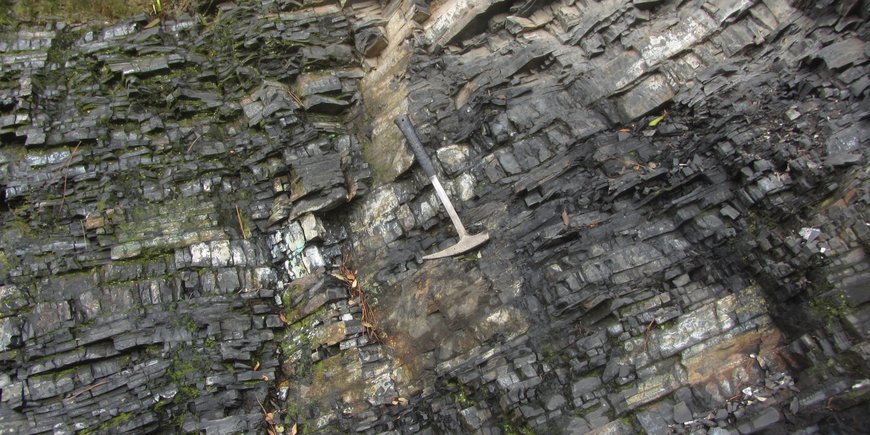Summary
The early oceans were not as hot as previously thought. This is shown by researchers from the University of Göttingen and the GFZ German Research Centre for Geosciences in Potsdam in a study recently published in the scientific journal PNAS. They analysed oxygen isotope ratios in 550 million year-old chert, a sedimentary rock formed in seawater. Based on modelling, the researchers see the cause for the temporal course of the isotope ratios not in the cooling of the oceans, but in the cooling of the solid Earth. Their results thus provide a new answer to the long-disputed question of what information these rocks record over the course of Earth's history. Based on the new findings, Archean ocean temperatures could be reconstructed more accurately from rock samples in the future. The study is thus central to understanding the development of life on Earth.
Background: Puzzling changes in oxygen isotopes
In the course of Earth's history, cherts, quartz-rich sediments that form from seawater and silica, show a puzzling increase in the ratio of their oxygen isotopes 18O/16O: The ratio of the heavier isotope 18O to the lighter isotope 16O has continuously increased by about 15 per mil since the Archean, the time about 4 to 2.5 billion years ago, until today, from about 17 per mil to 32 per mil.
There are two widely accepted approaches to explaining this phenomenon: firstly, that the early oceans were hot (over 70 degrees Celsius) and then cooled steadily. Secondly, the early oceans were very poor in the heavier oxygen 18O and the 18O/16O ratio continuously increased.
However, both scenarios are difficult to reconcile with other geological and geochemical observations, such as climate cycles and the occurrence of certain microorganisms in the ocean.
New explanation: oxygen isotope ratios controlled by the cooling of the solid Earth
Now researchers led by Michael Tatzel, formerly a PhD candidate at the GFZ and now a junior professor at the University of Göttingen, together with Patrick Frings and other colleagues from the GFZ German Research Centre for Geosciences, have shown that the oxygen isotope ratios in cherts are controlled by the constant cooling of the solid Earth over geological time. The rocks themselves are therefore no good archives for seawater temperatures of the past.
Investigations on 550 million year old samples
The research team examined around 550 million-year-old chert samples from southeast China, among other things using mass spectrometric methods to measure the isotopic composition precisely.
The analyses document that after the deposition of sedimentary mud, the amorphous, i.e. still disordered, precursors of chert crystallise at depths of hundreds of metres, virtually storing the temperatures prevailing at that depth in their oxygen-isotope ratio.
Modelling leads to new understanding of the process
In order to study the exact relationships, the researchers now modelled the process of chert rock formation and how this impacts oxygen isotope ratios. The microcrystalline quartz rock is formed from amorphous silicon dioxide and pore water through a sequence of stepwise transformations in the form of dissolution and precipitation reactions. The researchers found that the 18O/16O isotope ratio is determined by the conditions under which the quartz formed from the amorphous precursors in the sediment. These are primarily the isotope ratio of oxygen in the pore water and the ambient temperatures in the depth zone in which the transformation occurs.
The heat flow from the Earth's interior decreases as the Earth slowly cools over billions of years. "Our calculations show that the isotopic ratio of 18O/16O becomes larger as the heat flow decreases. The lower the temperatures during crystallisation, the more of the heavy oxygen 18O is incorporated into quartz," says the study's first author, Michael Tatzel. In this way, about one third of the 18O/16O increase can be explained. At the same time, cooling of the Earth leads to a decrease in the 16O content of seawater from which chert precursors form.
Complex correlations between ocean temperature and oxygen isotope ratio
The puzzle of isotopically light Archean cherts is thus solved by the roughly doubled heat flow on the early Earth. "Cherts are obviously not good archives for seawater temperatures in the past. Our findings mean that we have to think oxygen isotopes in cherts in a completely new way, because heat flow has a significant impact on the 18O/16O ratios," says Tatzel.
Joint first author Patrick Frings from GFZ Potsdam adds: "I think this work will open the door to some exciting new developments in the coming years. Because the cherts do not provide us with a direct archive of past ocean temperatures, as some researchers have assumed so far. But our knowledge of the heat flow effect could in future make it possible to accurately reconstruct sea water temperatures in deep geological time. In addition, we will be able to decipher the thermal structure and tectonic history of ancient sedimentary basins."
Temperate climate on early Earth - without hot oceans
The calculated effect of heat flow for oxygen isotopes in cherts also means that the light Archean cherts are indicative of a moderate to warm climate on the early Earth - hot Archean oceans seem very unlikely. This conclusion is central to understanding about the evolution of life on the young Earth.
Original publication:
M. Tatzel, P. J. Frings, M. Oelze, D. Herwartz, N. K. Lünsdorf, and M. Wiedenbeck; Chert oxygen isotope ratios are driven by Earth's thermal evolution; PNAS 2022 119 (51); DOI: 10.1073/pnas.2213076119









![[Translate to English:] Torsten Sachs in front of a climate station on a field](/fileadmin/_processed_/3/9/csm__TorstenSachs_bearbeitet_GS_4a1365ef84.jpeg)

![[Translate to English:] left image flood at the Ahrtal: image from above, several houses are flooded; left image:: Heidi Kreibich;](/fileadmin/_processed_/4/4/csm_Bild2_9af0130e9f.png)



![[Translate to English:] Start der Vega Rakete](/fileadmin/_processed_/6/4/csm_20231201-kachel_Vega-VV23-launch_ESA-CNES-Arianespace_706716b68c.jpeg)









![[Translate to English:] Poster exhibition at the Brandenburg Hydrogen Day at the GFZ, some participants in the foreground](/fileadmin/_processed_/6/5/csm_Erster_Brandenburgischer_Wasserstofftag_GFZ_402fcec95e.jpeg)
![[Translate to English:] Group picture of the participants](/fileadmin/_processed_/9/4/csm_20231108_CAWa-Workshop-Tashkent_Gruppenbild_99ea779d8a.jpeg)

![[Translate to English:] [Translate to English:] Hörsaal](/fileadmin/_processed_/e/6/csm_H%C3%B6rsal_e21ac645fb.jpeg)


![[Translate to English:] The Delegations in the Historic Library on the Telegrafenberg. In the back there are from left to right, the Dutch Ambassador for Germany, Ronald van Roeden, the Dutch Minister for Education, Culture and Science, Robbert Dijkgraaf and the scientific director of the GFZ, Susanne Buiter.](/fileadmin/_processed_/d/b/csm_Kachel-2_9eba4b4212.jpeg)

